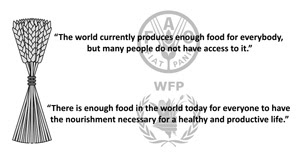Hunger is not a random condition. The problem is that many people in the world don’t have money to buy food. Hunger is caused by poverty and inequality, not scarcity. Overpopulation isn't the cause of hunger, "fixing" overpopulation won't fix hunger. In fact, the obsession with overpopulation often leads to precious aid money being spent on population control rather than real aid. "Family planning" programs miss the real point, especially in places like Africa--which is that the people need legitimate, concrete aid.
There is enough food in the world today for everyone to have the nourishment necessary for a healthy and productive life. For the world as a whole, per capita food availability has risen from about 2220 kcal/person/day in the early 1960s to 2790 kcal/person/day in 2006-08, while developing countries even recorded a leap from 1850 kcal/person/day to over 2640 kcal/person/day. The FAO has maintained consistently that, on the basis of availability of suitable land for rain-fed and irrigated agriculture, enough food could be produced for the much larger human population predicted for 30 years from now.
The world's farmers are harvesting hundreds of millions of tons more grain each year on tens of millions acres less land than they did in the 1970s and '80s. For instance, according to USDA figures, the world was producing 1.9 million metric tons of grain from 579.1 hectares of land (a hectare is 2.47 acres) in 1976. In 2004, we got 3.1 million metric tons of grain from only 517.9 hectares of land.
The world produces 17% more food per person today than 30 years ago. But close to a billion people go to sleep hungry every night. The world already produces more than 1 ½ times enough food to feed everyone on the planet. That’s enough to feed 10 billion people, the population peak we expect by 2050. The call to double food production by 2050 only applies if we continue to prioritize the growing population of livestock and automobiles over hungry people. The bulk of industrially-produced grain crops goes to biofuels and animal feed rather than food for the 1 billion hungry. And then there is the unnecessary loss through waste. An estimated 25 percent of the world’s food calories and up to 50 percent of total food weight are lost or wasted before they can be consumed.
Half the food in the world is produced by 1.5 billion farmers working small plots for which monocultures of any kind are unsustainable. Agroecological practices which is basically farming like a diversified ecosystem conserve soils and water and have proven to produce the most rapid, recognizable and sustainable results. In areas in which soils have already been degraded by conventional agriculture’s chemical “packages”, agroecological methods can increase productivity by 100-300 percent. 400 experts commissioned for the four-year International Assessment on Agriculture, Science and Knowledge for Development (IAASTD 2008) concluded that agroecology and locally-based food economies (rather than the global market) where the best strategies for combating poverty and hunger.
There is enough food in the world today for everyone to have the nourishment necessary for a healthy and productive life. For the world as a whole, per capita food availability has risen from about 2220 kcal/person/day in the early 1960s to 2790 kcal/person/day in 2006-08, while developing countries even recorded a leap from 1850 kcal/person/day to over 2640 kcal/person/day. The FAO has maintained consistently that, on the basis of availability of suitable land for rain-fed and irrigated agriculture, enough food could be produced for the much larger human population predicted for 30 years from now.
The world's farmers are harvesting hundreds of millions of tons more grain each year on tens of millions acres less land than they did in the 1970s and '80s. For instance, according to USDA figures, the world was producing 1.9 million metric tons of grain from 579.1 hectares of land (a hectare is 2.47 acres) in 1976. In 2004, we got 3.1 million metric tons of grain from only 517.9 hectares of land.
The world produces 17% more food per person today than 30 years ago. But close to a billion people go to sleep hungry every night. The world already produces more than 1 ½ times enough food to feed everyone on the planet. That’s enough to feed 10 billion people, the population peak we expect by 2050. The call to double food production by 2050 only applies if we continue to prioritize the growing population of livestock and automobiles over hungry people. The bulk of industrially-produced grain crops goes to biofuels and animal feed rather than food for the 1 billion hungry. And then there is the unnecessary loss through waste. An estimated 25 percent of the world’s food calories and up to 50 percent of total food weight are lost or wasted before they can be consumed.
Half the food in the world is produced by 1.5 billion farmers working small plots for which monocultures of any kind are unsustainable. Agroecological practices which is basically farming like a diversified ecosystem conserve soils and water and have proven to produce the most rapid, recognizable and sustainable results. In areas in which soils have already been degraded by conventional agriculture’s chemical “packages”, agroecological methods can increase productivity by 100-300 percent. 400 experts commissioned for the four-year International Assessment on Agriculture, Science and Knowledge for Development (IAASTD 2008) concluded that agroecology and locally-based food economies (rather than the global market) where the best strategies for combating poverty and hunger.


No comments:
Post a Comment